Mushrooms of a vibrant orange hue may suddenly manifest in your lawn or yard, seemingly appearing overnight. These conspicuous bright orange mushrooms can be easily spotted among the blades of grass, particularly in shaded areas or on decaying tree trunks. The species of these orange fungi can grow in clustered formations with a spongy texture or possess cylindrical stems accompanied by rounded or flat caps featuring gills on their undersides.
While certain types of orange mushrooms, such as the golden chanterelle, are safe for consumption, many others are highly toxic. For instance, the toxic Jack-O’lantern mushroom (Omphalotus olearius) resembles the chanterelle due to its similar shape and deep yellow to orange cap.
This article serves as a general guide to identifying common varieties of orange mushrooms found in lawns and yards. However, it does not provide advice on distinguishing edible orange mushrooms from poisonous ones. Foraging mushrooms for consumption requires expertise and experience, so it is crucial to correctly identify the species before consuming any type of mushroom.
Descriptions and images of orange mushrooms and toadstools will help you recognize their distinguishing features. Continue reading to discover the various types of wild orange mushrooms that may be thriving in your yard.
Orange Mushrooms in the Lawn
Clusters of orange mushrooms frequently grace lawns during the autumn season, particularly after periods of abundant rainfall. The striking shades of bright to deep orange exhibited by these fruiting fungi create a vivid contrast against the dark green turf. Some common orange mushrooms found in lawns include the Jack-O’lantern (Omphalotus olearius), orange peel mushroom (Aleuria aurantia), and the vibrant orange goblet waxcap mushroom (Hygrocybe Cantharellus).
The Presence of Mushrooms in Yards
Orange mushrooms can be found in yards due to the fruiting activity of fungi present in the soil under favorable conditions. Like all fungi, these wild orange mushrooms are small structures that flourish in nutrient-rich soil, shaded environments, warm temperatures, and high humidity. As a result, you are likely to come across lawn mushrooms during late summer and fall.
In your yard, you will probably encounter orange mushrooms near decomposing organic matter, particularly in shaded areas. Shrubs, mulch, grass, and the base of tree trunks that enter the ground are common locations for wild mushrooms to thrive.
If you stumble upon brightly colored orange or orange-red mushrooms in your yard, it is generally best to leave them undisturbed. However, if you are uncertain about their species and have children or pets playing in the area, it is advisable to remove them.
Identifying Orange Mushrooms
Apart from their orange coloration, identifying features of orange mushrooms include the shape of their caps, stems, and their overall size. After picking a mushroom, examine the underside of the cap to determine whether it has gills, pores, or a spongy texture. Additionally, observe the color of the mushroom and the flesh.
Edible mushroom species may exhibit brown, orange, or tan gills, brownish-orange caps, and smooth caps devoid of scales or warty growths. Furthermore, there should be no veil-like ring encircling the stem. Nevertheless, these guidelines are general in nature, and it is essential to rely on more than just these criteria when identifying mushrooms.
Types of Orange Mushrooms – Identification Guide with Pictures
Now, let us delve into the distinctive characteristics of common orange mushrooms, ranging from shades of yellow-orange, red-orange, to pale orange adorned with white spots. It is highly likely that some of these orange mushroom varieties are flourishing in your lawn or backyard.
Jack-O’Lantern Mushroom (Omphalotus olearius and Omphalotus illudens)

The jack-o’lantern mushroom is among the most prevalent orange mushrooms found in yards. This species, known for its deep orange hues, features a broadly convex or indented cap, bright yellowish-orange to brownish-orange coloration, gills that extend along its tapering stem, and pale orange flesh.
The jack-o’lantern is a sizable orange mushroom, with its cap measuring between 1.5 to 4.7 inches (4 to 12 cm) in width, while its thick orange stem stands at 1.3 to 3.5 inches (4.3 to 9 cm) in height. In addition to growing in yards, this orange mushroom commonly emerges at the base of tree stumps and roots.
Orange Mushroom Identification:
The jack-o’lantern mushroom can be recognized by its orange hue, brownish-orange cap, and fluted gills tapering down the stem. Furthermore, this mushroom exhibits bioluminescence, emitting a bluish-green glow.
Chanterelle Mushrooms

Chanterelle mushrooms are medium-sized, orange to yellow edible mushrooms characterized by their broadly flat or convex orange caps. These orange chanterelles may exhibit a slightly depressed center of the cap, false gills beneath the cap, and pale yellowish flesh. Certain species of chanterelles can appear red-orange to deep red, such as the red chanterelle.
Pale yellowish-orange chanterelles boast a distinct vase shape. These delectable mushrooms reach heights of 1.5 to 2.3 inches (4 to 6 cm), with caps measuring 1.1 to 4 inches (3 to 10 cm) in width. Chanterelles are prevalent throughout North America, often found in coniferous forests and shaded areas.
Orange Mushroom Identification:
Chanterelle mushrooms are easily identifiable due to their yellow-orange color, elongated tapering stems, and tiny black scales adorning the cap.
Orange Fly Agaric (Amanita muscaria var. guessowii)

The orange fly agaric is an extremely poisonous mushroom featuring a cylindrical white stem, orange cap, and white warty growths. The large orange cap may have an umbrella shape or resemble a flattened disc. This orange-red mushroom also encompasses a variant known as the red fly agaric, exhibiting a bright red and white toadstool appearance.
With a cap diameter ranging from 2.7 to 8.2 inches (7 to 21 cm), this orange fly agaric stands at a height of 2.7 to 7 inches (7 to 18 cm). While it occasionally grows in lawns within shaded and sheltered locations, this orange mushroom is typically found near birch trees or in coniferous woodlands.
Orange Mushroom Identification:
The orange fly agaric possesses a rounded orange cap adorned with small bumpy white growths. Its flesh and gills are white, while the cap exhibits a distinct orange-red hue.
Orange Peel Fungus (Aleuria aurantia)
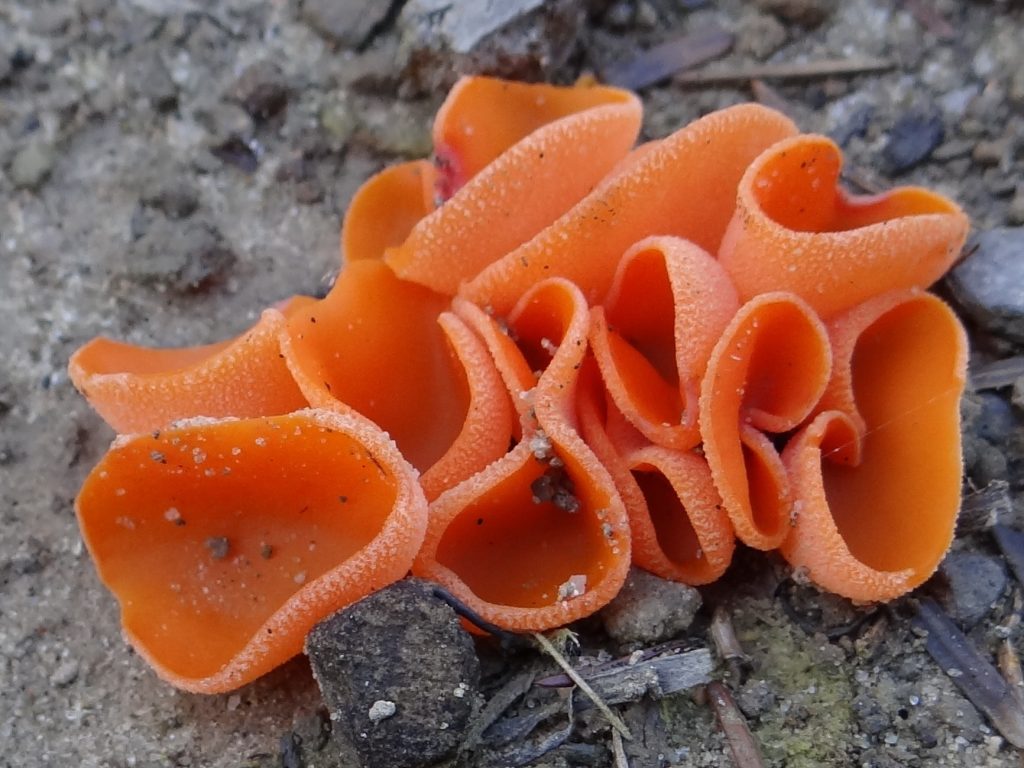
The cup-shaped orange peel fungus is a brilliant orange mushroom that features a unique crinkled appearance. This common orange fungus in lawns is easily distinguished by its wavy, smooth, and bright orange cap, resembling a large slice of curled orange peel. Furthermore, the irregularly shaped fungus exhibits a fuzzy underside.
The fruiting body of this peculiar stemless orange fungus spans from 0.6 to 2.7 inches (1.5 to 7 cm) in diameter. It is frequently encountered in grassy areas, trails, and residential yards.
Orange Mushroom Identification:
The distinctive orange peel fungus boasts a cupped shape, sometimes with a split down one side. As the mushroom matures, it becomes flatter.
The Orange Bonnet Mushroom

The orange bonnet is an orange mushroom that grows in dense clusters, distinguished by its slender, curving stem and bell-shaped cap. As the orange cap develops, it takes on a conical shape. The underside of the cap reveals closely spaced orange gills with red-orange margins, while the mushroom’s base appears densely hairy.
Cluster-forming orange mushrooms of this type reach lengths of 1.1 to 2.7 inches (3 to 7 cm), featuring wiry stems a few millimeters thick. The small, slimy orange caps measure between 0.39 to 1.5 inches (1 to 4 cm) in width, exhibiting a somewhat rounded, conical appearance. These clusters of orange mushrooms can be found on the forest floor in deciduous forests.
Orange Mushroom Identification:
The tiny orange mushrooms possess dull orange caps situated atop slender yellowish-green stems, with bright orange gills beneath the cap.
Goblet Waxcap (Hygrocybe cantharellus)
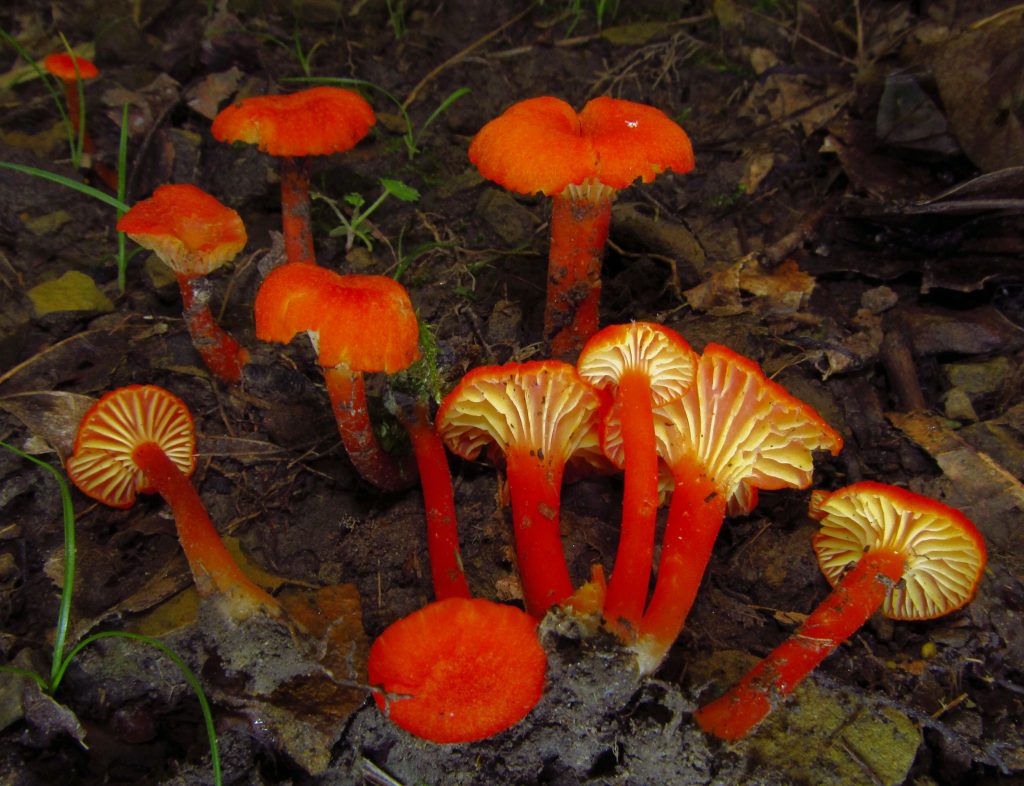
The goblet waxcap is a small, bright orange mushroom with a long, slender orange stem, a round orange cap featuring in-rolled margins, and attractive white to yellowish-white gills beneath. Additional identifying features of this orange mushroom include its sticky texture, bright orange cap with a scalloped margin, and yellow-orange flesh.
The diminutive goblet waxcap mushroom measures 1.1 to 2.75 inches in length (3 to 7 cm), while its small disc-like orange cap spans from 0.2 to 0.78 inches (0.6 to 2 cm) in diameter. These orangish mushrooms often grow in loose clusters near hardwood trees in deciduous woodlands, and occasionally in lawns.
Orange Mushroom Identification:
Identifying features of the goblet waxcap include its long, slender stem, white gills, and broadly convex, scalloped cap that feels sticky to the touch.
Red Pine Mushroom (Lactarius deliciosus)
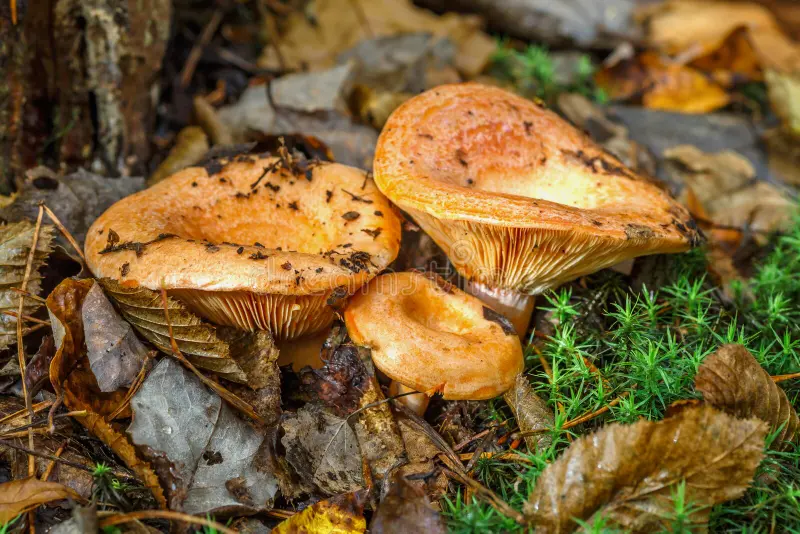
The red pine mushroom boasts a robust, vase-shaped structure with a carrot-orange cap that becomes sticky when wet. This stout orange mushroom exhibits noticeable pale orange gills tapering down the stem. When fresh, the fungus secretes an orange-red sticky liquid and develops greenish stains upon handling.
Also known as the saffron milk cap due to the latex-like orange liquid it emits, the red pine squat mushroom reaches heights of 1 to 3 inches (3 to 8 cm) and spans from 1.5 to 5.5 inches (4 to 14 cm) across. True to its name, this orange mushroom is commonly found in coniferous forests near pine trees.
Orange Mushroom Identification:
The short, stumpy orange pine mushroom can be identified by its vase-shaped appearance, mottled patterns, and evenly spaced yellow gills.
Bradleys Mushroom (Lactarius volemus)
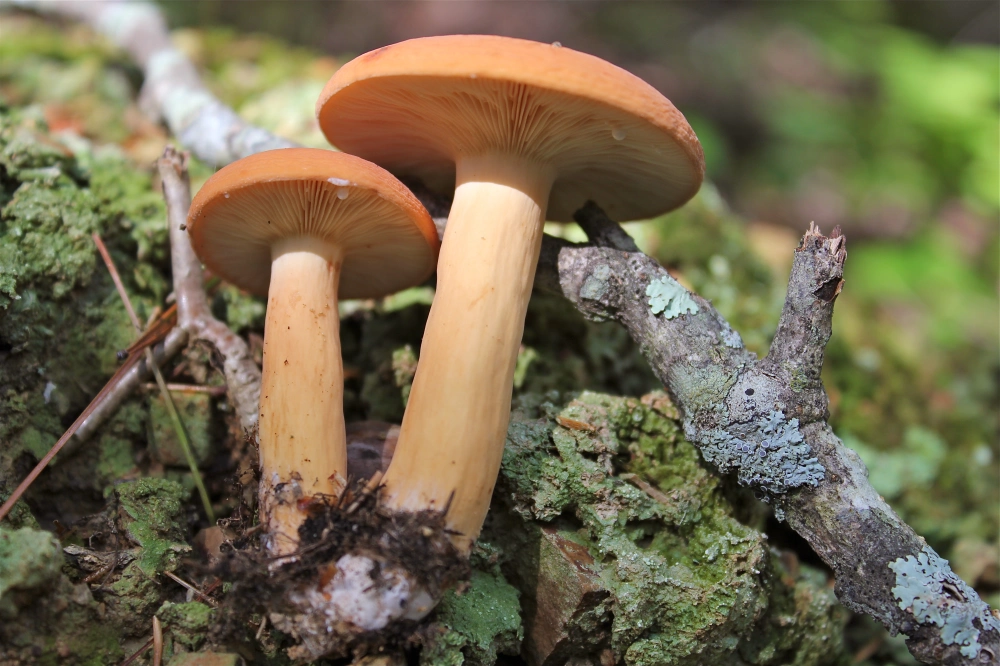
Bradleys mushroom is an edible orange mushroom featuring an inward-turning, burnt orange round cap, bright yellow gills, and a thick, tubular stem. This orange mushroom typically grows solitary. Additional characteristics of this orangish-brown mushroom include milky-white sap, tapering gills, and flesh that stains brown.
Bradleys mushroom reaches heights of 2 to 4 inches (5 to 10 cm), with its large disc-shaped cap measuring between 1.1 to 5.1 inches (3 to 13 cm) in diameter.
Orange Mushroom Identification:
The apricot to tawny-colored cap of Bradleys mushroom, occasionally dark brownish-red, distinguishes it. However, this orange mushroom is primarily known for its pungent fish-like odor and the copious milky white sap it releases when cut.
Woolly Chanterelle (Turbinellus floccosus)
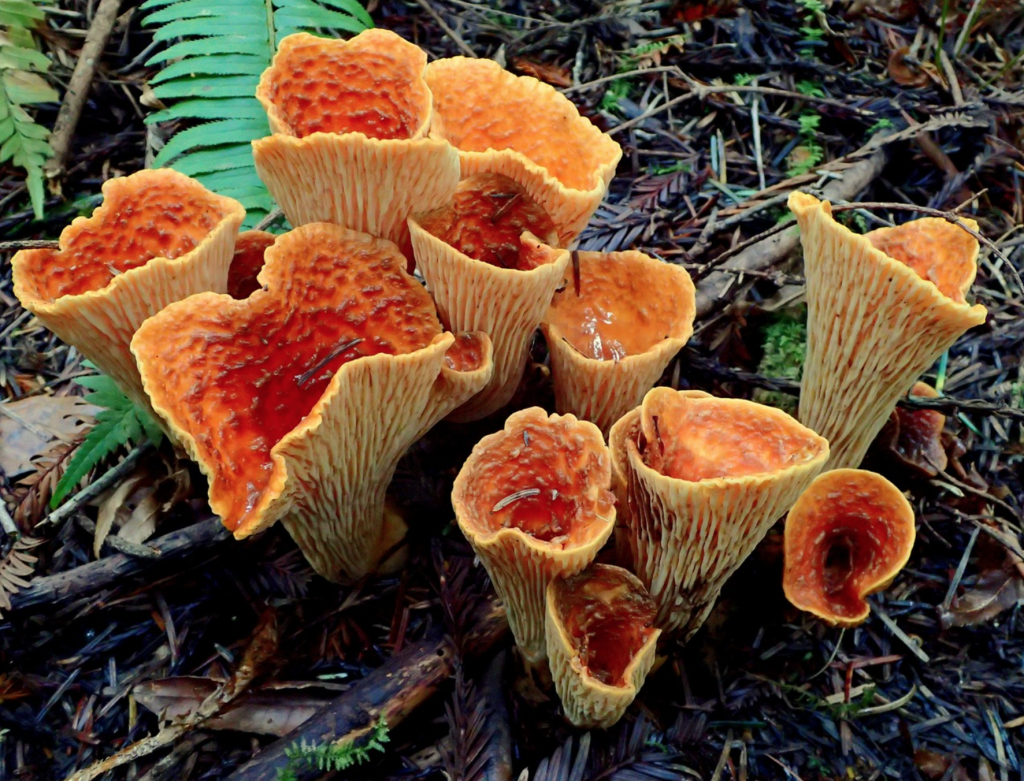
The unmistakable woolly chanterelle is a vase-shaped, fleshy orange mushroom featuring a dark orange to brown upper surface and bright white gills on the underside. As it grows near conifer trees, the fruiting body takes on a trumpet shape. The mushroom’s fibrous flesh discolors easily, displaying brown patches.
This distinctive orange mushroom reaches heights of up to 12 inches (30 cm) and spans an equal width. The wide top and tapered gills, with their pale buff to whitish or yellowish ridged appearance, make the woolly chanterelle easily recognizable.
Orange Mushroom Identification:
The woolly chanterelle stands out due to its cylindrical vase-shaped appearance, thick, fibrous flesh, and hues ranging from deep red to yellowish-orange.
Jackson’s Slender Amanita (Amanita jacksonii)
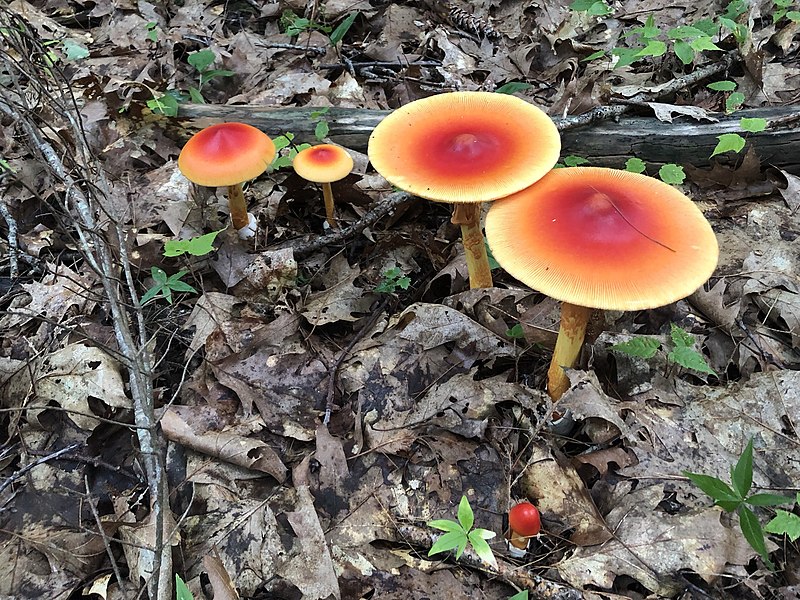
The Jackson’s slender amanita is a relatively large orange mushroom featuring a tall, cigar-shaped stem and a deep orange convex or umbrella-shaped cap. Distinctive features of this wild orange mushroom include yellow stems, yellowish gills, and a bright orangey-red appearance. Additionally, the mushroom’s cap has a smooth, sticky texture.
The Jackson’s slender amanita stands at heights of 3.5 to 6 inches (9 to 15 cm), with its cap spanning from 2 to 4.7 inches (5 to 12 cm) across. This edible orange mushroom is easily mistaken for poisonous varieties like the fly amanita.
Orange Mushroom Identification:
The identifying features of the Jackson’s slender amanita include its tacky, orangey-red convex cap, yellowish gills, and slender yellow cylindrical erect stem.
Chicken of the Woods Mushrooms (Laetiporus sulphureus)
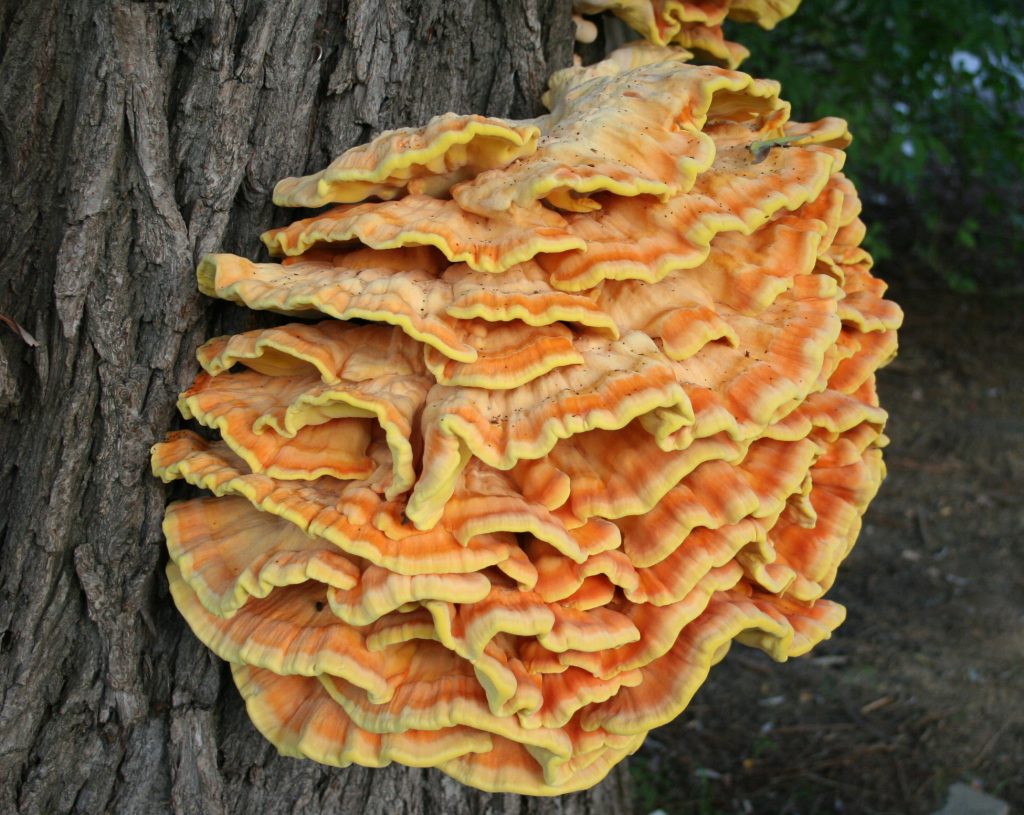
Chicken of the woods is a cluster-forming orange fungus that manifests as shelf-like, overlapping growths on trees. This parasitic golden yellow or orange fungus resembles fan-shaped shelves on decaying tree trunks. Fresh specimens emit a strong earthy aroma and exude a pale, transparent yellow liquid.
The shelf-like structures of this common woodland fungus measure between 2 and 24 inches (5 to 60 cm) and can reach a thickness of up to 1.5 inches (4 cm). Due to its clumping nature, the large yellowish-orange fungus can form extensive growths. Moreover, this parasitic fungus causes the demise of the host tree long before the edible, yellow-pored fungus becomes visible.
Orange Mushroom Identification:
The easily identifiable chicken of the woods boasts large golden orange shelf-like structures attached to decaying oak tree trunks. Other common names for this orange fungus include sulphur shelf, crab of the woods, and sulphur polypore.
The Golden Trumpet (Xeromphalina Campanella)

The golden trumpet mushroom is a small rusty brown to dark orange mushroom that grows in dense clusters. This orange mushroom exhibits an umbrella-shaped cap, thin dark orange stem, and pale orange gills. As the mushroom matures, the bell-shaped caps grow upward, creating a distinctive vase shape.
Measuring between 0.6 to 1.1 inches in height (1.5 to 3 cm), the tiny orange mushrooms have yellowish-orange caps ranging from 0.2 to 1 inch (0.5 to 2 cm) in diameter. Clusters of these orange mushrooms are commonly found on fallen logs and old tree stumps, particularly those of decaying conifers.
Also referred to as the bell omphalina or golden trumpet, these moisture-loving fungi can be observed throughout the year.
Orange Mushroom Identification:
The golden trumpet mushroom clusters are easily recognizable due to their umbrella-shaped caps, thin stems, and small sizes.
Conical Waxy Cap (Hygrocybe conica)

The conical waxy cap is a small orange-topped or red-capped mushroom with a pointed, sticky cap, erect yellow-orange stem, and white or orange-red gills. The orange mushroom caps emerge in a sharply conical shape, gradually flattening into a broadly convex form with a pointed tip in the center.
Also known as the witch’s hat due to its cap’s shape, this orange conical waxy cap reaches heights of 1.18 to 3.14 inches (3 to 8 cm), with caps measuring between 0.39 to 1.5 inches (1 to 4 cm) in diameter. These pretty orangish mushrooms are often found under oak trees in woodlands.
Orange Mushroom Identification:
The conical waxy cap features a distinctive broad cap with wavy margins and a pointed center.
Lobster Mushroom (Hypomyces lactifluorum)
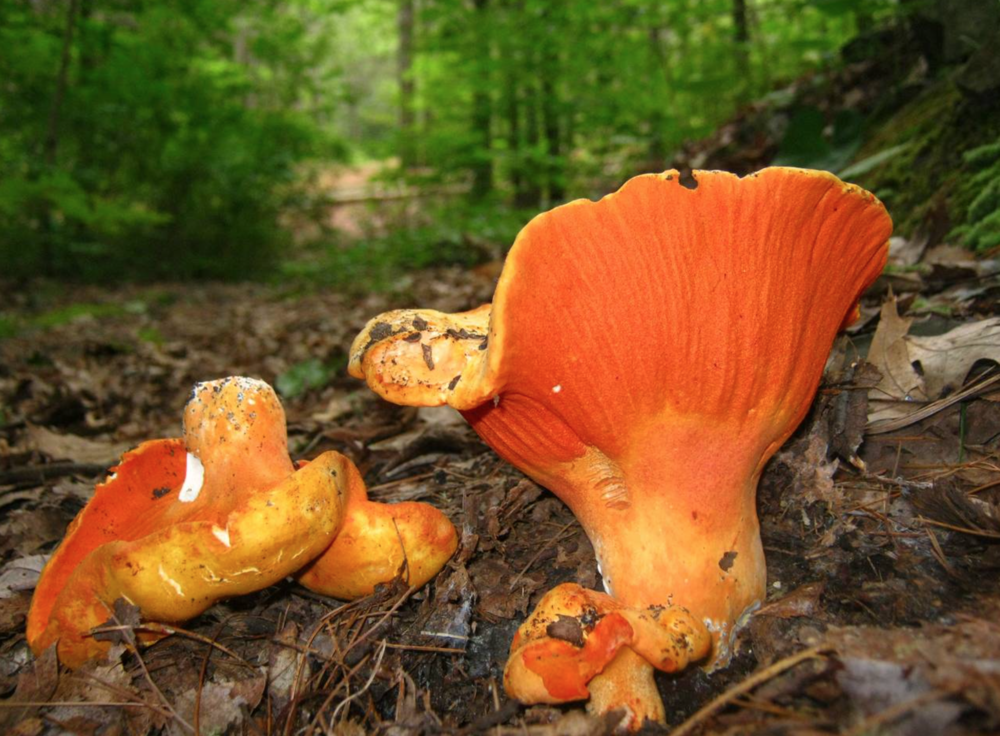
The lobster mushroom is not a mushroom itself but rather a parasitic fungus that attaches to certain mushroom species, transforming them into a reddish-orange color. The affected fungi take on a distinct cooked lobster appearance, with a bright orange outer skin. As the parasitic fungus grows, it alters the shape of the host mushroom, resulting in a tough texture and vibrant orange color.
The size of lobster mushrooms varies based on the size of the host mushroom. While lobster mushrooms are edible fungi and can be found in some grocery stores, their seafood-like flavor and dense texture make them a delicacy.
Orange Mushroom Identification:
The lobster mushroom is identifiable by its bright reddish-orange coloration and hard surface adorned with small white pimples.